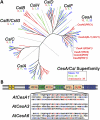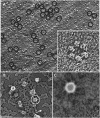Update on mechanisms of plant cell wall biosynthesis: how plants make cellulose and other (1->4)-β-D-glycans
- PMID: 21051553
- PMCID: PMC3075763
- DOI: 10.1104/pp.110.163360
Update on mechanisms of plant cell wall biosynthesis: how plants make cellulose and other (1->4)-β-D-glycans
Figures






Similar articles
-
Cellulose synthesis: a complex complex.Curr Opin Plant Biol. 2008 Jun;11(3):252-7. doi: 10.1016/j.pbi.2008.03.007. Epub 2008 May 14. Curr Opin Plant Biol. 2008. PMID: 18485800 Review.
-
Phosphorylation of cellulose synthases in plant responses to environmental changes.Int J Biol Macromol. 2025 Mar;292:139313. doi: 10.1016/j.ijbiomac.2024.139313. Epub 2024 Dec 29. Int J Biol Macromol. 2025. PMID: 39740718 Review.
-
Biosynthesis of cellulose.Adv Carbohydr Chem Biochem. 1983;41:105-53. doi: 10.1016/s0065-2318(08)60057-8. Adv Carbohydr Chem Biochem. 1983. PMID: 6227209 Review. No abstract available.
-
Cellulose microfibrils in plants: biosynthesis, deposition, and integration into the cell wall.Int Rev Cytol. 2000;199:161-99. doi: 10.1016/s0074-7696(00)99004-1. Int Rev Cytol. 2000. PMID: 10874579 Review.
-
Cellulose metabolism in plants.Int Rev Cytol. 2005;247:1-34. doi: 10.1016/S0074-7696(05)47001-1. Int Rev Cytol. 2005. PMID: 16344110 Review.
Cited by
-
Purification and characterization of a soluble β-1,4-glucan from bean (Phaseolus vulgaris L.)-cultured cells dehabituated to dichlobenil.Planta. 2013 Jun;237(6):1475-82. doi: 10.1007/s00425-013-1861-9. Epub 2013 Feb 28. Planta. 2013. PMID: 23455460
-
Mannan synthase activity in the CSLD family.Plant Signal Behav. 2011 Oct;6(10):1620-3. doi: 10.4161/psb.6.10.17989. Epub 2011 Oct 1. Plant Signal Behav. 2011. PMID: 21904114 Free PMC article.
-
Insights into the structure and function of membrane-integrated processive glycosyltransferases.Curr Opin Struct Biol. 2015 Oct;34:78-86. doi: 10.1016/j.sbi.2015.07.008. Epub 2015 Sep 2. Curr Opin Struct Biol. 2015. PMID: 26342143 Free PMC article. Review.
-
The reference genome of Miscanthus floridulus illuminates the evolution of Saccharinae.Nat Plants. 2021 May;7(5):608-618. doi: 10.1038/s41477-021-00908-y. Epub 2021 May 6. Nat Plants. 2021. PMID: 33958777 Free PMC article.
-
Cellulose microfibril crystallinity is reduced by mutating C-terminal transmembrane region residues CESA1A903V and CESA3T942I of cellulose synthase.Proc Natl Acad Sci U S A. 2012 Mar 13;109(11):4098-103. doi: 10.1073/pnas.1200352109. Epub 2012 Feb 28. Proc Natl Acad Sci U S A. 2012. PMID: 22375033 Free PMC article.
References
-
- Arabidopsis Genome Initiative (2000) Analysis of the genome sequence of the flowering plant Arabidopsis thaliana. Nature 408: 796–815 - PubMed
-
- Arioli T, Peng LC, Betzner AS, Burn J, Wittke W, Herth W, Camilleri C, Höfte H, Plazinski J, Birch R, et al. (1998) Molecular analysis of cellulose biosynthesis in Arabidopsis. Science 279: 717–720 - PubMed
-
- Atanassov II, Pittman JK, Turner SR. (2009) Elucidating the mechanisms of assembly and subunit interaction of the cellulose synthase complex of Arabidopsis secondary cell walls. J Biol Chem 284: 3833–3841 - PubMed
-
- Bacic A, Delmer DP. (1981) Stimulation of membrane-associated polysaccharide synthetases by a membrane potential in developing cotton fibers. Planta 152: 346–351 - PubMed
Publication types
MeSH terms
Substances
LinkOut - more resources
Full Text Sources
Other Literature Sources

